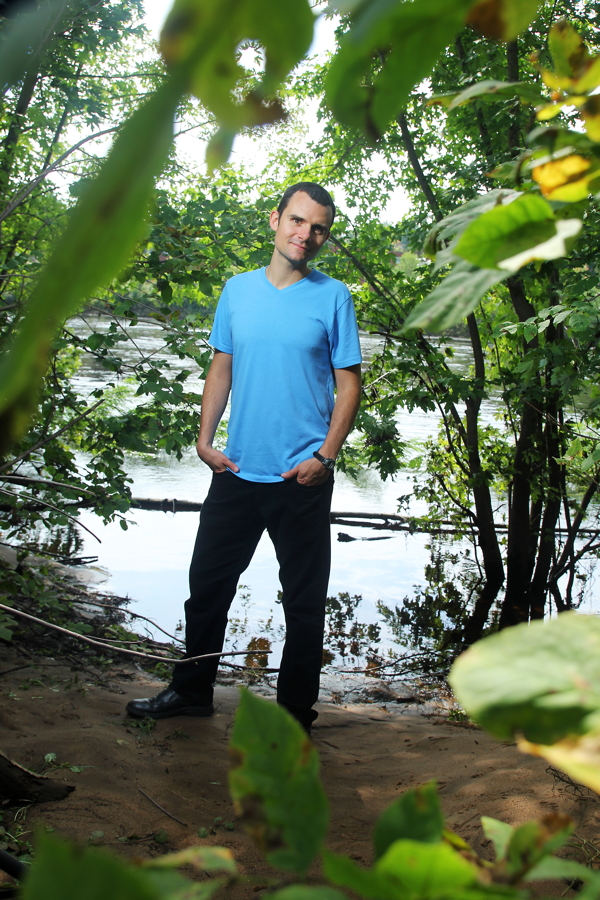Diving for the Truth
Hollars blends fact and fiction for drowning tales
Tom Giffey, photos by Andrea Paulseth |

I’m not sure I trust B.J. Hollars anymore.
It’s not that Hollars has done anything untrustworthy to me. In fact – and please forgive me for injecting myself into this story – the UW-Eau Claire English professor happens to be my friend and neighbor. We’ve babysat each other’s kids, drank beer on each other’s porches, and walked each other’s dogs. And yet, I’m suddenly compelled to find him untrustworthy – an uncomfortable situation considering he’s got a copy of my house key.
So why am I suddenly suspicious of Hollars? It has to do with his new book, Dispatches from the Drownings: Reporting the Fiction of Nonfiction. Hollars has written or edited seven books, and his prior efforts include both fiction and nonfiction. As its subtitle implies, his latest effort straddles the line between fact and fiction – or, to put it another way, between what we accept as fact and what we suspect might be fiction. Or perhaps it’s the other way around? As someone who’s spent his adult life putting the facts down on paper, you can see why I find the work unsettling.
So what’s the book about, exactly? On the most basic level, it’s a collection of 100 brief articles from Eau Claire newspapers about drownings (and near-drownings) that occurred between the 1870s and the 1920s. It’s a numbing parade of everyday tragedies from a place where our rivers and lakes still prove deadly. Except – and here’s the tricky party – not all of the stories are real. Twenty-five of the dispatches are fabrications composed by Hollars, and the book offers no indication which tales are real and which are fictional. To his credit, Hollars fesses up to his fakery from the beginning. As he writes in the book’s introduction, “If the truth is in the telling, then I’m telling you – right now – that not all of these stories are true.”
“(The book is) actually about the limits of reporting, how the reporter along a riverbank can never fully understand the experience of the one in the river.” – author B.J. Hollars, on Dispatches from the DrowningsIn an interview, Hollars explains that the book is “actually about the limits of reporting, how the reporter along a riverbank can never fully understand the experience of the one in the river.” In this way, drowning serves as an apt vehicle for demonstrating the limits of reporting: Observers can speculate all they want about why a drowning occurred, what the mental state of the victim was, and how he or she struggled against the pull of the river, but for the most part they’re just guessing. “When we remove the reporter from the riverbank – as is often the case – then we’re left with a reporter reporting a story secondhand,” Hollars continues. “How much of our news is acquired this way? Filtered through a filter that wasn’t even witness to the scene.”
Hollars admits to being haunted by Eau Claire’s rivers. He first became interested – or, perhaps the more accurate word is “obsessed” – with their dangers when on his first morning in Eau Claire a few years ago he went for a run and encountered a rescue crew searching for a body in the Chippewa River. Later, he became familiar with the book Wisconsin Death Trip by Michael Lesy, a 1973 cult classic that combines morbid tales culled from 19th-century Black River Falls newspapers with eerie vintage photos by Charles Van Schaick, the town’s photographer. In his book, Lesy recontextualized history to paint a dark portrait of small-town Wisconsin. As Lesy did more than 40 years ago, Hollars also illustrates his work with Van Schaick’s stark images.
Hollars says he doesn’t mean to trivialize real tragedies through his fiction. “Rather, I am trying to draw our attention to a threat that continues to plague our community,” he says. “In addition, I hope to remind readers of another threat: taking everything we read at face value.”
In an era when we are bombarded with more information than ever before, this reminder is a welcome one. Instead of distrusting B.J., maybe I should be thanking him for revealing the truth about the “truth.”
Dispatches from the Drownings: Reporting the Fiction of Nonfiction by B.J. Hollars, is available at The Local Store, 205 N. Dewey St., or online at bjhollars.com. Hollars will read from his book at 6:30pm Tuesday, Oct. 7, at the Volume One Gallery, 205 N. Dewey St.




















